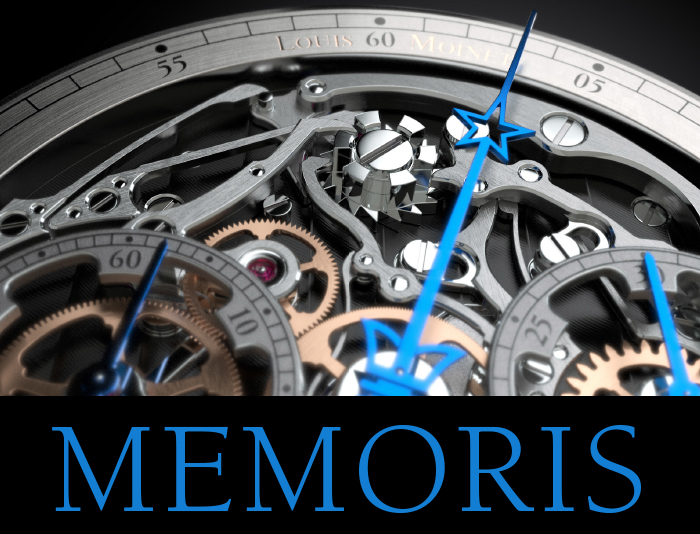 In honour of the memory of its illustrious founder – and in the year of its tenth anniversary – Louis Moinet unveils a visionary creation, positioning the chronograph not simply as a complication – but as a central component of the watch.
In honour of the memory of its illustrious founder – and in the year of its tenth anniversary – Louis Moinet unveils a visionary creation, positioning the chronograph not simply as a complication – but as a central component of the watch.
“It’s probably the most important launch we’ve ever done.” Jean-Marie Schaller, CEO of Louis Moinet, gets straight to the point in presentingMemoris. The timepiecestands at a historic crossroads: the Ateliers’ tenth anniversary, and the bi-centenary of the chronograph invented by Louis Moinet.
As such, it was important for the creation to be markedly different from its forebear, as well as celebrate its heritage. While everything – oralmost everything – chronograph-related already seems to have been invented, there was still one step nobody had dared take: no longer seeing the chronograph as a complication, but rather as the primary function of the timepiece. And so Memoris, the first watch chronograph in watchmaking history, was born.
The chronographas the primary function – and time as the complication
The concept began to come into being almost three years ago now, with Louis Moinet starting again from scratch. “We couldn’t draw inspiration from what had gone before; everyone else worked from the premise that the chronograph was an additional complication on top of the time function,” explains Jean-Marie Schaller. “Our starting point was the opposite: sweeping away the past and making the chronograph the starting point of our design; the central component to which we then added a time function, rather than the other way round.”
In short, Ateliers Louis Moinet did exactly what the eponymous inventor of the chronograph did in his day;taking a completely different approach to watchmaking rather than attempting merely to improve on an existing model. Indeed, that’s how Moinet invented the chronograph and was the first to achieve high frequencies – among his other remarkable lifetime achievements.
A single guiding principle: forget the past and start from scratch
The starting point may be easy to understand, but turning it into mechanical reality required a great deal of effort. Sharing its strategic thinking with Concepto, the movement manufacturer that hasworked alongside the brand since its outset, Louis Moinet considered the usual set of traditional watchmakingquestions, but applied them to the chronograph: what should be highlighted, what techniques should be used, and what should be shown off?
A thorough knowledge of the history of watchmaking led to the first answers. There can be no doubt that any noble chronograph must have a traditional clutch column wheel. What’s more, tradition dictates that it should have a single pusher, the most delicate part of the exercise. And given its central role, it made sense to highlight the chronograph by having it occupy pride of place on the dial.
That left the question of what to leave visible, on display. For Louis Moinet, the answer here was quite simply everything: withMemoris, theentire chronograph function has been shifted to the dial.
As a result, the timepiece lives up to every possible expectation. Each aspect of the chronograph’s action can be admired as it is engaged, stopped and reset. The graceful ballet of the column wheel, cams and gears is a fascinating sight, free from distractions: Louis Moinet has opted to place the workings of what has here become a “time complication”to the rear of the movement, beneath the plate. The chronograph reigns in splendid isolation on the dial, leaving the beholder in no doubt that it is neither a skeleton nor an additional component: theall-new movement has been designed for the chronograph alone, and places it centre stage.
A wholly new approach to the casing
To showcase the chronograph in the style it deserves, Louis Moinet has redeveloped practically everydecorative item, with a new case, new hands, a new dial, a new oscillating weight, a new foldover catch, and more.
practically everydecorative item, with a new case, new hands, a new dial, a new oscillating weight, a new foldover catch, and more.
As a bonus, Louis Moinet has come up with a completely exclusive use of jewels. These parts – usually destined to serve as good pivots and make the components of the movement move smoothly –have been put to a new use elsewhere, featuring in the caselugs. “We decided that smooth, effortless rotationdidn’t need to be reserved solely for the gear train,” explains Jean-Marie Schaller.
The final resultof all this is Memoris: a 46mm timepiece, available in rose gold or white gold, in two limited editions of just 60 pieces each. Embodying the essence of true commemoration – all the life of the present, rooted inhistory –it links Louis Moinet’s heritagewith the creative vision of the Ateliers that today honour his memory.
The inner workings of Memoris
Over sixty parts have been designed and manufactured to allow the chronograph to be presented atop a dedicated movement plate, separating it from the automatic movement beneath.
The swivel of the yoke has been made concentric with the second wheel to improve the engagement of the moving parts.
“Energie Plus” is a clever, automatic pawl winding system that provides greater efficiency by allowing the watch to be wound up in both directions.
In addition to “Energie Plus”, a miniature ceramic ball bearingmounted on the dual-material rotor makes winding up operations smoother by minimizing friction.
The new caliber on the Memoris is the LM54. With a rhythm of 28,800 vibrations per hour (4Hz), it has 302 components and provides a 48-hour power reserve.
About Louis Moinet
Ateliers Louis Moinet was founded in Saint-Blaise, Neuchâtel, in 2004. The fully-independent firm was established to honour the memory of Louis Moinet (1768-1853): master watchmaker, certified inventor of the chronograph (1816), and pioneer in the use of very high frequencies (216,000 vibrations per hour). Louis Moinet was a watchmaker, scholar, painter, sculptor and teacher at the School of Fine Arts – as well as the author of Traité d’Horlogerie, a watchmaking treatise published in 1848 that remained a definitive work of reference for almost a century. Ateliers Louis Moinet is perpetuating this legacy. The firm’s timepieces, produced in limited editions only, have won some of the most coveted awards, including a Red Dot Design Award (Best of the Best category), a prize in the International Chronometry Competition, and a recent UNESCO Award of Merit. Louis Moinet creations often make use of unusual materials, such as fossils and meteorites, in a unique creative approach combined with bespoke fine watchmaking complications. The brand’s core values are creativity, exclusivity, art and design.

